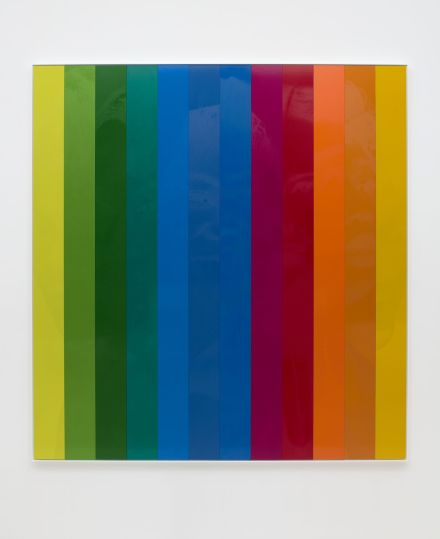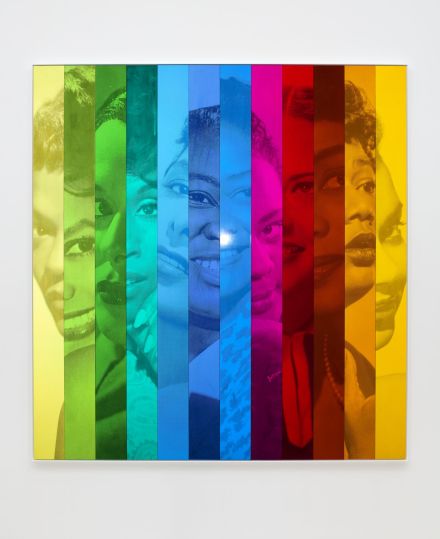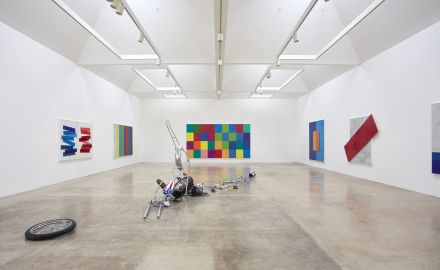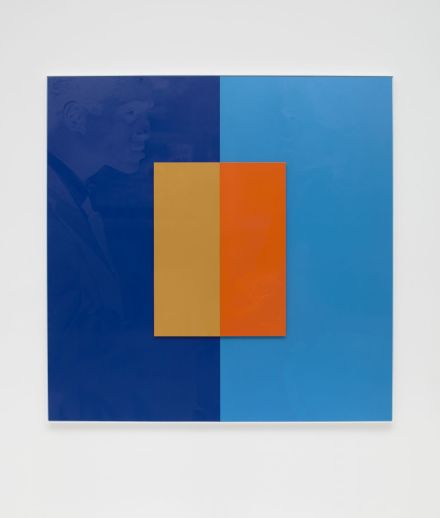
Hank Willis Thomas, “People just like to look at me” (Spectrum IX) (variation without flash) (2019), via Kayne Griffin Corcoran
Currently on at LA heavyweight Kayne Griffin Corcoran, Hank Willis Thomas marks his first solo exhibition with the space with An All Colored Cast, an exploration of color theory, popular culture, the development of Pop Art, Color Field painting, Minimalism, and the Hollywood film industry. In this new body of work, Thomas examines the portrayals of gender, race, and identity through the lens of film, performance, and color motion pictures.

Hank Willis Thomas, “People just like to look at me” (Spectrum IX) (variation with flash) (2019), via Kayne Griffin Corcoran
Thomas’s work has long mined intersections of presence and politics, race and representation in media and in the broader social sphere, and here he turns his focus directly on to the entertainment industry, the neon-tinged signifier of Los Angeles at large. Using color theory and screen color calibration charts as an aesthetic starting point, Thomas re-examines the language surrounding “color correction” and “white balance” in order to demonstrate the charged language of color, particularly around the time of desegregation and the proliferation of Technicolor in America. His works present screen caps and frames from film and television, Hollywood film stills and mid-century posters from black-cast films, often inflected with the tropes and gestures of colorfield painting and abstract minimalism. Divergent histories are allowed to mingle and collide in his compositions, resulting in an interrogation of history that reflects in particular on the nature of skin tone and screen tone in conjunction, often as a barrier to more equitable representation and social justice, both on-screen and off.

Hank Wills Thomas, An All Colored Cast (Installation View)

Hank Willis Thomas, “C’est si bon” (Le Harmonie del Colore) (variation without flash) (2019), via Kayne Griffin Corcoran
Thomas’s sculptures in turn create both a pause for reflection and an opportunity for the viewer to step out the frame, forced to contend with signifiers of violent film representations (li Add Mediake the final scene of Easy Rider), while his retroreflective works—which are activated by flash photography—encourage a viewer to look closely, each welcoming inflection points where the language of art history is forced to contend with historical analogs often critically disengaged from the work. At the same time that these historical precedents were being set, Thomas seems to indicate, the policing of skin color and visibility on-screen was at its peak. A connection between color and exploration, the idea of freedom and expression both in the world, and on the canvas, dominates the show.

Hank Willis Thomas, “Interaction of Color” (Josef Albers diptych) (variation with flash) (2019), via Kayne Griffin Corcoran
Much of Thomas’ work demands that viewers shift their position and engage directly in order to see a moment in its entirety, as a reminder of the multiple ways of looking at a given moment or subject. Through this invitation to participate, the viewer plays an active role as an agent and image-maker.
The show closes March 7th.
— D. Creahan
Read More:
Hank Wills Thomas at Kayne Griffin Corcoran [Exhibition Site]



